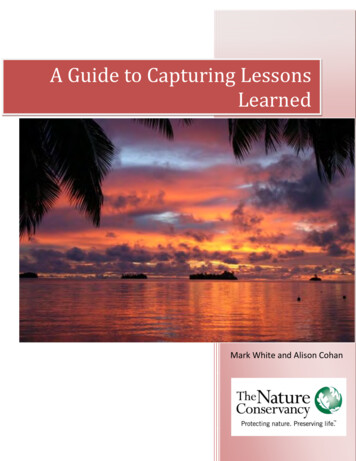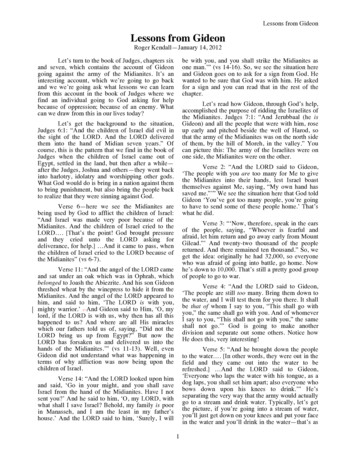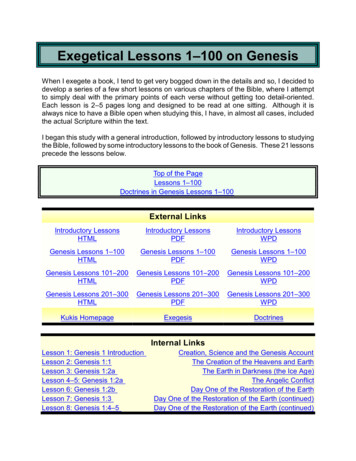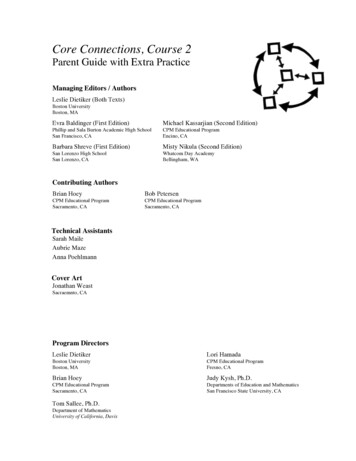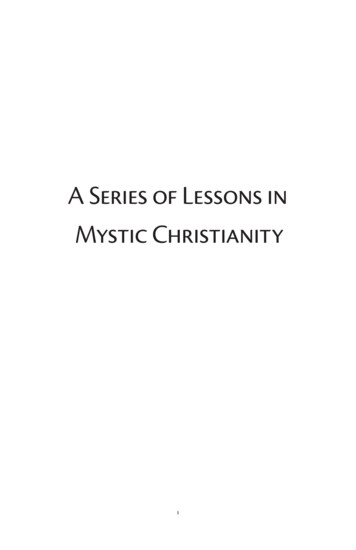
Transcription
A Series of Lessons inMystic Christianityi
A Series of Lessons in Mystic ChristianityWritingsThe Hindu‑Yogi Science of BreathHatha Yoga or The Yogi Philosophy of Physical Well‑BeingFourteen Lessons in Yogi Philosophy and Oriental OccultismAdvanced Course in Yogi Philosophy and Oriental OccultismThe Science of Psychic HealingA Series of Lessons in Raja YogaThe Bhagavad Gita or The Message of the MasterThe Spirit of the UpanishadsA Series of Lessons in Gnani YogaA Series of Lessons in Mystic Christianity or The Inner Teachings of the MasterThe Hindu‑Yogi System of Practical Water CureLife Beyond DeathA Series of Lessons on The Inner Teachings of The Philosophies and Religions of Indiaii
A Series of Lessons inMystic ChristianityThe Inner Teachings of The Master1908Yogi Ramacharaka1862–1932信YOGeBooks: Hollister, MO2013:09:07:09:13iii
A Series of Lessons in Mystic ChristianityCopyrightYOGeBooks by Roger L. Cole, Hollister, MO 65810 2010 YOGeBooks by Roger L. ColeAll rights reserved. Electronic edition published 2010isbn: 978‑1‑61183‑018‑7 (pdf)isbn: 978‑1‑61183‑019‑4 (epub)www.yogebooks.comiv
IndexThe First Lesson. The Coming of the Master.The Second Lesson. The Mystery of the Virgin Birth.The Third Lesson. The Mystic Youth of Jesus.The Fourth Lesson. The Beginning of the Ministry.The Fifth Lesson. The Foundation of the Work.The Sixth Lesson. The Work of Organization.The Seventh Lesson. The Beginning of the End.The Eighth Lesson. The End of the Life Work.The Ninth Lesson. The Inner Teachings.The Tenth Lesson. The Secret Doctrine.The Eleventh Lesson. The Ancient Wisdom.The Twelfth Lesson. The Message of the Master.v
A Series of Lessons in Mystic Christianityvi
Publishers’ Notice.The lessons which compose this volume originallyappeared in monthly form, the first of which was issuedin October, 1907, and the twelfth in September, 1908.These lessons met with a hearty and generous response fromthe public, and the present volume is issued in response tothe demand for the lessons in a permanent and durable form.There has been no change in the text.The publishers take the liberty to call the attention of thereaders to the great amount of information condensed withinthe space of each lesson. Students have told us that they havefound it necessary to read and study each lesson carefully, inorder to absorb the varied information contained within itspages. They have also stated that they have found it advisable tore‑read the lessons several times, allowing an interval betweenthe readings, and that at each reading they would discoverinformation that had escaped them during the course of theprevious study. This has been repeated to us so often that wefeel justified in mentioning it, that others may avail themselvesof the same plan of study.Following his usual custom, the writer of this volume hasdeclined to write a preface for this book, claiming that thelessons will speak for themselves, and that those for whom theyvii
A Series of Lessons in Mystic Christianityare intended will receive the message contained within themwithout any prefatory talk.The Yogi Publication Society.September 1, 1908.viii
A Series of Lessons inMystic Christianity1
A Series of Lessons in Mystic Christianity2
The First Lesson.The Coming of the Master.The Forerunner.trange rumors reached the ears of the people of Jerusalemand the surrounding country. It was reported that a newprophet had appeared in the valley of the lower Jordan,and in the wilderness of Northern Judea, preaching startlingdoctrines. His teachings resembled those of the prophets of old,and his cry of “Repent! Repent ye! for the Kingdom of Heaven isat hand,” awakened strange memories of the ancient teachers ofthe race, and caused the common people to gaze wonderinglyat each other, and the ruling classes to frown and look serious,when the name of the new prophet was mentioned.The man whom the common people called a prophet, andwhom the exalted ones styled an impostor, was known asJohn the Baptist, and dwelt in the wilderness away from theaccustomed haunts of men. He was clad in the rude garmentsof the roaming ascetics, his rough robe of camel’s skin beingheld around his form by a coarse girdle of leather. His diet wasfrugal and elemental, consisting of the edible locust of theregion, together with the wild honey stored by the bees of thewilderness.S3
A Series of Lessons in Mystic ChristianityIn appearance John, whom men called “the Baptist,” wastall, wiry, and rugged. His skin was tanned a dark brown by thewinds and sun which beat upon it unheeded. His long blackhair hung loosely around his shoulders, and was tossed likethe mane of a lion when he spoke. His beard was rough anduntrimmed. His eyes gleamed like glowing coals, and seemedto burn into the very soul of his hearers. His was the face of thereligious enthusiastic with a Message for the world.This wild prophet was most strenuous, and his teachings werecouched in the most vigorous words. There was no tact, policy,or persuasion in his message. He hurled his verbal thunderboltsright into his crowd, the very force and earnestness emanatingfrom him serving to charge his words with a vitality andmagnetism which dashed itself into the crowd like a spark ofelectricity, knocking men from off their feet, and driving theTruth into them as if by a charge of a powerful explosive. Hetold them that the spiritual grain was to be gathered into thegarners, while the chaff was to be consumed as if by a fieryfurnace; that the axe was to be laid to the root of the treeswhich brought not forth good fruit. Verily, the “Day of Jehovah,”long promised by the prophets, was near to hand to his hearersand followers.John soon gathered to himself a following, the peopleflocking to him from all parts of the country, even from Galilee.His followers began to talk among themselves, asking whetherindeed this man were not the long promised Master—theMessiah for whom all Israel had waited for centuries. This talkcoming to the ears of the prophet, caused him to answer thequestion in his discourses, saying: “There cometh one mightierthan I, after me, the latchet of whose shoes I am not worthy tostoop down and unloose; he that cometh after me is mightierthan I.” And thus it became gradually known to his following,and the strangers attending his meetings, that this John theBaptist, mighty preacher though he be, was but the heraldof one much greater than he, who should follow—that he4
The Coming of the Masterwas the forerunner of the Master, according to the Orientalimagery which pictured the forerunner of the great dignitaries,running ahead of the chariot of his master, crying aloud toall people gathered on the road that they must make way forthe approaching great man, shouting constantly, “Make ye away! make ye a way for the Lord!” And accordingly there was anew wave of excitement among John’s following, which spreadrapidly to the surrounding country, at this promise of thecoming of the Lord—the Master—perhaps even the Messiahof the Jews. And many more came unto John, and with himwaited for the Coming of the Master.This John the Baptist was born in the hill country of Judea,nearly thirty years before he appeared as a prophet. His fatherwas of the priestly order, or temple caste, who had reached anadvanced age, and who lived with his aged wife in retirement,away from the noise and confusion of the world, waiting thegradual approach of that which cometh to all men alike. Thenthere came to them a child of their old age, unexpected andunhoped for—coming as a mark of especial favor from God—ason, to whom they gave the name of Johanan, which in theHebrew tongue means “Jehovah is gracious.”Reared in the home of his parents—the house of a priest—John saturated himself with all the Inner Teachings reservedfor the few, and withheld from the masses. The Secrets of theKaballah, that system of Hebrew Occultism and Mysticismin which the higher priests of Judea were well versed, weredisclosed to him, and occult tradition has it that he wasinitiated into the Inner Circle of the Hebrew Mystics, composedof only priests of a certain grade, and their sons. John becamean Occultist and a Mystic. When the boy reached the age ofpuberty, he departed from the home of his parents, and wentinto the wilderness, “looking to the East, from whence comethall Light.” In other words, he became an Ascetic, living in thewilderness, just as in India even to‑day youths of the Brahminor priestly class sometimes forsake their homes, renouncing5
A Series of Lessons in Mystic Christianitytheir luxurious life, and fly to the jungle, where they wanderabout for years as ascetics, wearing a single garment, subsistingon the most elementary food, and developing their spiritualconsciousness. John remained a recluse until he reached the ageof about thirty years, when he emerged from the wilderness topreach the “Coming of the Lord,” in obedience to the movingsof the Spirit. Let us see where he was, and what he did, duringthe fifteen years of his life in the wilderness and hidden placesof Judea.The traditions of the Essenes, preserved among Occultists,state that while John was an ascetic he imbibed the teachingsof that strange Occult Brotherhood known as the Essenes, andafter having served his apprenticeship, was accepted into theorder as an Initiate, and attained their higher degrees reservedonly for those of developed spirituality and power. It is said thateven when he was a mere boy he claimed and proved his rightto be fully initiated into the Mysteries of the Order, and wasbelieved to have been a reincarnation of one of the old Hebrewprophets.The Essenes.The Essenes were an ancient Hebrew Occult Brotherhood,which had been in existence many hundred years before John’stime. They had their headquarters on the Eastern shores of theDead Sea, although their influence extended over all of Palestine,and their ascetic brothers were to be found in every wilderness.The requirements of the Order were very strict, and its rites andceremonies were of the highest mystical and occult degree. TheNeophyte was required to serve a preliminary apprenticeship ofone year before being admitted to even partial recognition asa member and brother. A further apprenticeship of two moreyears was required before he was admitted to full membership,and extended the right hand of fellowship. Additional time wasrequired for further advancement, and even time alone did notentitle the member to certain high degrees, the requirements6
The Coming of the Masterbeing that actual knowledge, power and attainment must firstbe manifested. As in all true Occult Orders the candidate must“work out his own salvation,” neither money nor influencehaving any weight.Absolute obedience to the Rules of the Order; absolutepoverty of material possessions; absolute sexual continence—these were the conditions of membership to be observed byboth Neophyte and Initiate, as well as High‑degree Master.Understanding this, one may imagine the disgust inspired inJohn by the amorous solicitations of Salome, which caused himto lose his life rather than to break the vows of his Order, as is sostartlingly pictured in the stage productions of modern times.One of the ceremonies of the Essenes was that of Baptism(literally, “dipping in water”) which was administered toCandidates, with appropriate solemnity and rites. The mysticsignificance of the ceremony which is understood by allmembers of Occult Orders, even unto this day, was a part ofthe ritual originated by the Essenes, and the rite itself was adistinctive feature of their Order. The performance of thisrite by John the Baptist, in his ministry, and its subsequentacceptance by the Christian Church as a distinctive ceremonial,of which the “sprinkling of infants” of to‑day is a reminder andsubstitute, forms a clear connecting link between the Essenesand Modern Christianity, and impresses the stamp of Mysticismand Occultism firmly upon the latter, as little as the generalpublic may wish to admit it in their ignorant misunderstandingand materialistic tendencies.The Essenes believed in, and taught the doctrine ofReincarnation; the Immanence of God; and many other OccultTruths, the traces of which appear constantly in the ChristianTeachings, as we shall see as we progress with these lessons.Through its Exalted Brother, John the Baptist, the Order passedon its teaching to the early Christian Church, thus grafting itselfpermanently upon a new religious growth, newly appearing onthe scene. And the transplanted branches are still there!7
A Series of Lessons in Mystic ChristianityOf course, the true history of the real connection betweenthe Essenes and Christianity is to be found only in the traditionsof the Essenes and other ancient Mystic Orders, much of whichhas never been printed, but which has passed down fromteacher to pupil over the centuries even unto this day, amongOccult Fraternities. But in order to show the student that weare not making statements incapable of proof by evidenceavailable to him, we would refer him to any standard work ofreference on the subject. For instance, if he will consult the“New International Encyclopedia” (vol. vii, page 217) article on“Essenes,” he will read the following words: “It is an interestingquestion as to how much Christianity owes to Essenism. Itwould seem that there was room for definite contact betweenJohn the Baptist and this Brotherhood. His time of preparationwas spent in the wilderness near the Dead Sea; his preachingof righteousness toward God, and justice toward one’s fellowmen, was in agreement with Essenism; while his insistence onBaptism was in accord with the Essenic emphasis on lustrations.”The same article contains the statement that the EssenicBrotherhood taught a certain “view entertained regardingthe origin, present state, and future destiny of the soul, whichwas held to be pre‑existent, being entrapped in the body as in aprison,” etc. (The above italics are our own.)John emerged from the wilderness when he had reached theage of about thirty years, and began his ministry work, whichextended for several years until his death at the hands of Herod.He gathered around him a large and enthusiastic following,beginning with the humbler classes and afterward embracinga number of higher social degree. He formed his moreadvanced followers into a band of disciples, with prescribedrules regarding fasting, worship, ceremonial, rites, etc., closelymodeled upon those favored by the Essenes. This organizationwas continued until the time of John’s death, when it mergedwith the followers of Jesus, and exerted a marked influenceupon the early Christian church.8
The Coming of the MasterAs we have stated, one of his principal requisites enjoinedupon all of his followers, was that of “Baptism”—the Essenic rite,from which he derived his familiar appellation, “The Baptist.”But, it must be remembered that to John this rite was a mostsacred, mystic, symbolic ceremony, possessing a deep occultmeaning unperceived by many of his converts who submittedthemselves to it under the fervor of religious emotion, and whonaively regarded it as some magical rite which “washed awaysin” from their souls, as the dirt was washed from their bodies,a belief which seems to be still in favor with the multitude.John worked diligently at his mission, and the “Baptists” or“Followers of Johanan,” as they were called, increased rapidly. Hismeetings were events of great moment to thousands who hadgathered from all Palestine to see and hear the prophet of thewilderness—the Essene who had emerged from his retirement.His meetings were often attended with startling occurrences,sudden conversions, visions, trances, etc., and many developedpossession of unusual powers and faculties. But one day therewas held a meeting destined to gain world‑wide fame. Thiswas the day when there came to John the Baptist the Master,of whose coming John had frequently foretold and promised.Jesus the Christ appeared upon the scene and confronted hisForerunner.The traditions have it that Jesus came unannounced to, andunrecognized by John and the populace. The Forerunner was inignorance of the nature and degree of his guest and applicantfor Baptism. Although the two were cousins, they had not metsince childhood, and John did not at first recognize Jesus. Thetraditions of the Mystic Orders further state that Jesus thengave to John the various signs of the Occult Fraternities towhich they both belonged, working from the common signs upuntil Jesus passed on to degrees to which John had not attained,although he was an eminent high‑degree Essene. WhereuponJohn saw that the man before him was no common applicantfor Baptism, but was, instead, a highest‑degree Mystic Adept,9
A Series of Lessons in Mystic Christianityand Occult Master—his superior in rank and unfoldment. John,perceiving this, remonstrated with Jesus, saying that it was notmeet and proper, nor in accordance with the customs of theBrotherhoods, for the inferior to Baptize the superior. Of thisevent the New Testament takes note in these words: “But Johnforbade him, saying, I have need to be baptized of thee, andcomest thou to me?” (Matthew 3:14) But Jesus insisted thatJohn perform the rite upon him upon the ground that Hewished to go through the ceremonial in order to set His stampof approval upon it, and to show that he considered himself asa man among men, come forth to live the life of men.In both the occult traditions and the New Testamentnarrative, it is stated that a mystical occurrence ensued at thebaptism, “the Spirit of God descending like a dove and lightingupon Him,” and a voice from Heaven saying: “This is my belovedSon in whom I am well pleased.”And with these words the mission of John the Baptist,as “Forerunner of the Master,” was fulfilled. The Master hadappeared to take up his work.***The Master.And, now, let us turn back the pages of the Book of Time,to a period about thirty years before the happening of theevents above mentioned. Let us turn our gaze upon the eventssurrounding the birth of Jesus, in order that we may tracethe Mystic and Occult forces at work from the beginning ofChristianity. There are occurrences of the greatest importanceembraced in these thirty years.Let us begin the Mystic Narrative of Jesus the Christ, as itis told to the Neophyte of every Occult Order, by the MasterInstructor, by a recital of an event preceding his birth by overone year.In Matthew 2:1–2, the following is related: “Now when Jesuswas born in Bethlehem of Judea, in the days of Herod the king,10
The Coming of the Masterbehold, there came Wise Men from the East to Jerusalem,saying, Where is he that is born King of the Jews? for we haveseen his star in the East, and are come to worship him.”In these simple words is stated an event that, expressed ina much more extended narrative, forms an important part ofthe Esoteric Teachings of the Mystic Brotherhoods, and OccultOrders of the Orient, and which is also known to the membersof the affiliated secret orders of the Western world. The story ofThe Magi is embedded in the traditions of the Oriental Mystics,and we shall here give you a brief outline of the story as it is toldby Hierophant to Neophyte—by Guru to Chela.To understand the story, you must know just who were these“Wise Men of the East”—The Magi. And this you shall now betaught.The Magi, or Wise Men.The translators of the New Testament have translated thewords naming these visitors from afar as “the Wise Men fromthe East,” but in the original Greek, Matthew used the words“The Magi” as may be seen by reference to the original Greekversions, or the Revised Translation, which gives the Greek termin a foot‑note. Any leading encyclopedia will corroborate thisstatement. The term “the Magi” was the exact statement ofMatthew in the original Greek in which the Gospel was written,the term “the Wise Men” originating with the English translators.There is absolutely no dispute regarding this question amongBiblical scholars, although the general public is not aware ofthe connection, nor do they identify the Wise Men with theOriental Magians.The word “Magi” comes to the English language direct fromthe Greek, which in turn acquired it by gradual steps from thePersian, Chaldean, Median, and Assyrian tongues. It means,literally, “wonder worker,” and was applied to the members ofthe occult priestly orders of Persia, Media, and Chaldea, whowere Mystic Adepts and Occult Masters. Ancient history is full11
A Series of Lessons in Mystic Christianityof references to this body of men. They were the custodians ofthe world’s occult knowledge for centuries, and the pricelesstreasures of the Inner Teachings held by the race to‑day havecome through the hands of these men—the Magi—whotended the sacred fires of Mysticism and kept The Flameburning. In thinking of their task, one is reminded of the wordsof Edward Carpenter, the poet, who sings:“Oh, let not the flame die out! Cherished age after age in its darkcaverns, in its holy temples cherished. Fed by pure ministers of love—let not the flame die out.”The title of “Magi” was highly esteemed in those ancient days,but it fell into disrepute in the latter times owing to its growinguse as an appellation of the practitioners of “Black Magic,” or“evil wonder‑workers” or sorcerers, of those days. But as a writerin the New International Encyclopedia (vol. xii, page 674) hastruly said: “The term is employed in its true sense by Matthew(2:1) of the wise men who came from the East to Jerusalem toworship Christ. The significance of this event must be observedbecause the Messianic doctrine was an old and establishedone in Zoroastrianism.” The same article says of the Magi: “ they believed in a resurrection, a future life, and the advent ofa savior.”To understand the nature of the Magi in connection withtheir occult “wonder working,” we must turn to the dictionaries,where we will see that the word “Magic” is derived from thetitle “Magi;” the word “Magician” having been originally“Magian”, which means “one of the Magi.” Webster defines theword “Magic” as follows: “The hidden wisdom supposed to bepossessed by the Magi; relating to the occult powers of nature;mastery of secret forces in nature”, etc. So you may readily seethat we are right in stating to you that these Wise Men—theMagi who came to worship the Christ‑child, were in reality therepresentatives of the great Mystic Brotherhoods and Occult12
The Coming of the MasterOrders of the Orient—Adepts, Masters, Hierophants! Andthus do we find the Occult and Mystic “wonder workers”—thehigh‑degree brethren of the Great Eastern Lodges of MysticOccultism, appearing at the very beginning of the Story ofChristianity, indicating their great interest in the mortal birthof the greater Master whose coming they had long waited—the Master of Masters! And all Occultists and Mystics findpleasure and just pride in the fact that the first recognition ofthe Divine Nature of this human child came from these Magifrom the East—from the very Heart of the Mystic Inner Circles!To those so‑called Christians to whom all that is connectedwith Mysticism and Occultism savors of the fiery sulphurand brimstone, we would call attention to this intimate earlyrelation between The Masters and The Master.The Star in the East.But the Mystic story begins still further back than the visitof the Magi to Bethlehem. Did not the Magi say, “Where is He?We have seen His star in the East and have come to worshiphim.” What is meant by the words, “We have seen his star inthe East”?To the majority of Christians the “Star of Bethlehem” meansa great star that suddenly appeared in the heavens, like a greatbeacon light, and which miraculously guided the steps of theMagi, mile by mile, on their weary journey, until at last it restedin the heavens, stationary over the house in which the childJesus lived, between the ages of one and two years. In otherwords, they believe that this star had constantly guided theseskilled mystics, occultists and astrologers, in their journeyfrom the far East, which occupied over a year, until it at lastguided them to Bethlehem and then stopped stationaryover the house of Joseph and Mary. Alas! that these vulgartraditions of the ignorant multitude should have served solong to obscure a beautiful mystic occurrence, and which bytheir utter improbability and unscientific nature should have13
A Series of Lessons in Mystic Christianitycaused thousands to sneer at the very true legend of the “Starof Bethlehem.” It remains for the Mystic traditions to clearaway the clouds of ignorance from this beautiful story, and tore‑establish it in the minds of men as a natural and scientificoccurrence.This story of the “traveling star” arose from the superstitiousand ignorant ideas of many of the Christians of the first, second,and third centuries after Christ’s death. These tales were injectedinto the manuscripts left by the disciples, and soon began to beregarded as a part and portion of the authentic Gospels andEpistles, although the skilled Biblical critics and scholars ofto‑day are rapidly discarding many of these additions as wilfulforgeries and interpolations. It must be remembered that theoldest manuscripts of the books of the New Testament areknown to Biblical scholars to have been written not less thanthree hundred years after the time of the original writing, and aremerely copies of copies of the originals, undoubtedly added to,altered, and adulterated by the writers through whose handsthey had passed. This is not merely the statement of an outsidecritic—it is a fact that is clearly stated in the writings of thescholars in the Churches engaged in the work of Biblical study,and the Higher Criticism, to which works we refer any who mayhave reason to doubt our statement.That portion of the verse (Matthew 2:9) in which it is saidthat “and lo; the star which they saw in the east went beforethem, till it came and stood over where the young childwas,” is known to the Mystic and Occult Orders to be a rankinterpolation into the story of the Magi. It is contrary to theirown traditions and records, and is also contrary to reason andto scientific laws, and this distorted story alone has been thecause of the development of thousands of “infidels” who couldnot accept the tale.All intelligent men know that a “star” is not a mere tiny pointof flame in the dome which shuts us out from a Heaven onthe other side of the blue shell, although this view was that14
The Coming of the Masterof the ancient people, and many ignorant men and womento‑day. Educated people know that a “star” is either a planetof our solar system, similar to the sister planet which we calledthe Earth, or else is a mighty sun, probably many times largerthan our sun, countless millions of miles distant from our solarsystem. And they know that planets have their invariable orbitsand courses, over which they travel, unceasingly, so true to theircourse that their movements may be foretold centuries ahead,or calculated for centuries back. And they know that even thegreat fixed stars, those distant suns and centers of great solarsystems akin to our own, have their own places in the Universe,also their Universal relations and movements. All who havestudied even the most elementary school book on astronomyknow these things. And yet such people are asked to swallowwhole this story of the “moving star,” traveling on a little aheadof the shepherds for over a year, and at last standing right overthe home of Jesus, and thus indicating that the search wasended. Let us compare this unscientific tale, with the traditionsand legends of the Mystics, and then take your choice.Had there been any such star in appearance, the historians ofthat day would surely have recorded it, for there were learnedand wise men in the East in those days, and as astrology was ascience closely studied, it would have been noted and passed onto posterity by both writings and tradition. But no such recordor tradition is to be found among the Eastern peoples, or therecords of the astrologers. But another record and tradition ispreserved, as we shall see in a moment.Yes, there really was a “Star of Bethlehem” which led thefeet of the Magi to the home of the infant Jesus. We have thefollowing proof of this fact: (1) the traditions and teachings ofthe Mystic Orders which have been handed down from teacherto student for centuries; (2) the statements and records ofthe Ancient Astrologers, which may be proven by modernastronomical calculations; and (3) the calculations made bymodern astronomers, which shall be stated a few paragraphs15
A Series of Lessons in Mystic Christianityfurther on. These three sources of information give us the sametale, as we shall see.Before proceeding to a consideration of this three‑foldevidence, let us pause for a moment and consider the relationof the Magi to Astrology. To understand the narrative of theMagi’s Visit to Jesus, we must remember that they were thevery Masters of Astrological Lore. Persia and the surroundingOriental countries were the fountain‑head of AstrologicalTeaching. And these Magi were Masters, and Adepts, andHierophants, and consequently knew all that was known tothe greatest schools of Astrology of that day. Much of theirAncient Astrological Lore has been lost to the race of to‑day,but to these ancient learned men it was as much of a scienceas chemistry and astronomy are to the learned ones of our day.The Magi had long waited for the appearance and incarnationof a Great Master of Masters, whose appearance had beenpredicted centuries before by some of the great Occult Fathersof the Mystic Orders, and each generation hoped that theevent would come in his day. They had been taught that whenthe event took place, they would be i
Kaballah, that system of Hebrew Occultism and Mysticism in which the higher priests of Judea were well versed, were disclosed to him, and occult tradition has it that he was initiated into the Inner Circle of the Hebrew Mystics, composed of only priests of a certain grad



